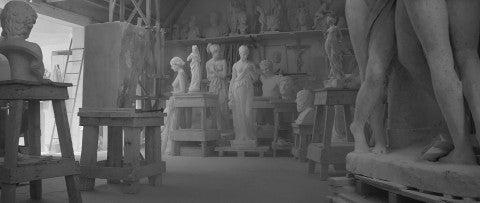Artist Adeline de Monseignat’s body of work reflects her interests in exploring tension and transformation through materials such as fur, glass, and marble, along with motifs like seeds, spheres, wheels, and ladders. Long interested in the uncanny, de Monseignat views her work as “an attempt to make the inanimate trigger emotional responses.” Through her evocative sculptures and films, she makes the familiar strange, the sensible absurd, and the inanimate come alive.
In 2015, she studied stone carving with sculptor Gianpetro Carlesso. Since then, marble, as well as its origins and production, have been integral to de Monseignat’s practice. She produced a series of marble sculptures titled In the Flesh between 2015 and 2016. Approximately a foot in diameter, each sphere of white-and-black marble features incisions resembling folds or creases. These simple marks render the hard, smooth surfaces flesh-like, transforming the geometric shapes into human forms.
In 2016, de Monseignat visited Carrara, one of Tuscany’s largest marble quarries. While exploring the space, she observed and photographed multiple ladders, and one in particular stayed with her. Its bent right leg made it appear lifelike as if it were a person casually leaning against a block of marble. De Monseignat imagined that had it remained there longer, it would have acquired a layer of the surrounding material, forming “marble flesh.” This notion inspired Echelle Charnelle (2018), a distorted eight-foot-tall steel ladder wrapped in a skin of black Monterrey marble.
For de Monseignat, ladders are anthropomorphic, and they also suggest “a journey, a state of transition, an upward motion synonymous with progress.” Nonetheless, just as one ascends a ladder to enter another space, one must also inevitably descend. This descent does not necessarily mean movement backwards; it also can be seen as a return home, to one’s origins, a theme explored in her 2016 film In the Flesh.
The film opens with a poignant quote from sculptor Dominique Stroobant, who asserts that stone weeps and is therefore alive—able to move and speak for those who listen. De Monseignat visualizes this idea by performing the role of a stone sculpture that awakens. Beautifully shot in black and white, the camera captures the misty mountainous cliffs surrounding Carrara before slowly panning into a sculptor’s studio filled with classical Roman-style busts and statues. The stillness of the space is interrupted when the head of a female figure suddenly jerks up to inhale. Moments later, the figure disappears.
The figure reappears lying on the ground of a quarry, coughing and in a fetal position as if being reborn. Indeed, her marble flesh has become human form as she squeezes her thigh and plucks a black strand of hair from her arm. The figure slowly rises to her feet and walks through the quarry to a lake where she submerges herself. As she descends, an inklike substance drops into the water, ostensibly from the stone cliffs above, where it spills over the edges.
The streaks of liquid evoke the tears of weeping stone. As de Monseignat explains, the film is “a tribute to the mountain, which sacrifices itself to give us sculptors a great and noble material to work with. . . . [The sculpture] is going back to her mother, the mountain.” She is “a creature that yearns to reconnect with her roots and crawl back into her mother’s womb, the quarry. By bringing to light the quarry’s ability to ‘live,’ the film also exposes its potential to ‘die.’” Are these tears of joy for the sculpture’s return, or are they mourning the death of the figure? In either case, In the Flesh conveys the emotional depth of the marble and the mountain, suggesting we share more in common with these inanimate forms than we often recognize. —Kanitra Fletcher

